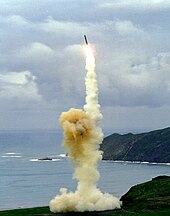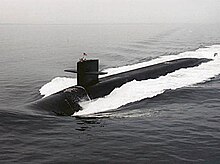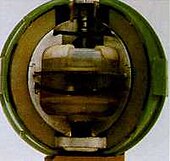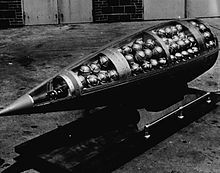From Wikipedia, the free encyclopedia
| United States of America | |
|---|---|
| Nuclear program start date | 21 October 1939 |
| First nuclear weapon test | 16 July 1945 |
| First fusion weapon test | 1 November 1952 |
| Last nuclear test | 23 September 1992 |
| Largest yield test | 15 Mt (1 March 1954) |
| Total tests | 1,054 detonations |
| Peak stockpile | 32,040 warheads (1966) |
| Current stockpile | 10,500 total |
| Maximum missile range | 13,000 km (8,100 mi) (land) 12,000 km (7,500 mi) (sub) |
| NPT signatory | Yes (1968, one of five recognized powers) |
| Weapons of mass destruction |
|---|
 |
| By type |
| By country |
| Proliferation |
| Treaties |
Contents
Nuclear weapons
Main article: Nuclear weapons and the United States
Nuclear weapons have been used twice in wartime: two nuclear weapons were used by the United States against Japan in World War II in the atomic bombings of Hiroshima and Nagasaki. Altogether, the two bombings killed an estimated 200,000 Japanese citizens and injured another 130,000.The U.S. conducted an extensive nuclear testing program. 1,054 tests were conducted between 1945 and 1992. The exact number of nuclear devices detonated is unclear because some tests involved multiple devices while a few failed to explode or were designed not to create a nuclear explosion. The last nuclear test by the United States was on September 23, 1992; the U.S. has signed but not ratified the Comprehensive Test Ban Treaty.
Currently, the United States nuclear arsenal is deployed in three areas:
- Land-based intercontinental ballistic missiles, or ICBMs;
- Sea-based, nuclear submarine-launched ballistic missiles, or SLBMs; and
- Air-based nuclear weapons of the U.S. Air Force's heavy bomber group
In the early 1990s, the U.S. stopped developing new nuclear weapons and now devotes most of its nuclear efforts into stockpile stewardship, maintaining and dismantling its now-aging arsenal. The administration of George W. Bush decided in 2003 to engage in research towards a new generation of small nuclear weapons, especially "earth penetrators" .[3] The budget passed by the United States Congress in 2004 eliminated funding for some of this research including the "bunker-busting or earth-penetrating" weapons.
The exact number of nuclear weapons possessed by the United States is difficult to determine. Different treaties and organizations have different criteria for reporting nuclear weapons, especially those held in reserve, and those being dismantled or rebuilt:
- As of 1999, the U.S. was said to have 12,000 nuclear weapons of all types stockpiled.[4]
- In its Strategic Arms Reduction Treaty (START) declaration for 2003, the U.S. listed 5968 deployed warheads as defined by START rules.[5]
- For 2007, the Bulletin of the Atomic Scientists listed the U.S. with about 5,400 total nuclear warheads: around 3,575 strategic and 500 nonstrategic warheads; and about 1,260 additional warheads held in the inactive stockpile. Other warheads are in some step of the disassembly process.[6]
- The exact number as of Sept. 30, 2009, was 5,113 warheads, according to a U.S. fact sheet released May 3, 2010.[7]
In 2010, The Pentagon disclosed that the current size of its nuclear arsenal is a total of 5,113 warheads operationally deployed, kept in active reserve and held in inactive storage. The figure does not include the estimated 4,600 warheads that have been retired and scheduled for dismantlement. The number of operationally deployed strategic warheads stands at 1,968.[10]
Land-based ICBMs
Heavy bomber group
The US Air Force also operates a strategic nuclear bomber fleet. The bomber force consists of 94 B-52 Stratofortresses, and 19 B-2 Spirits. All 64 B-1s were retrofitted to operate in a solely conventional mode by 2007 and are no longer counted as nuclear platforms.In addition to this, the US armed forces can also deploy smaller "tactical" nuclear weapons either through cruise missiles or with conventional fighter-bombers. The U.S. maintains about 400 nuclear gravity bombs capable of use by F-15, F-16, and F-35.[9] Some 350 of these bombs are deployed at seven airbases in six European NATO countries;[9] of these, 180 tactical B61 nuclear bombs fall under a nuclear sharing arrangement.[11]
Sea-based ICBMs
The US Navy currently has 18 Ohio-class submarines deployed, of which 14 are ballistic missile submarines. Each submarine is equipped with a complement of 24 Trident II missiles. Approximately 12 U.S. attack submarines are equipped to launch, but do not currently carry nuclear Tomahawk missiles. Sea-launch weapons make up the majority of weapons declared under START II rules. Some Trident missiles are equipped with the W88 warhead.Biological weapons
Main article: United States biological weapons program
The United States offensive biological weapons program was instigated by President Franklin Roosevelt and the U.S. Secretary of War in October 1941.[12] Research occurred at several sites. A production facility was built at Terre Haute, Indiana but testing with a benign agent demonstrated contamination of the facility so no production occurred during World War II.[13] A more advanced production facility was constructed in Pine Bluff, Arkansas, which began producing biological agents in 1954. Fort Detrick, Maryland
later became a production facility as well as a research site. The U.S.
developed anti-personnel and anti-crop biological weapons.[14]
Several deployment systems were developed including aerial spray tanks,
aerosol spray canisters, grenades, rocket warheads and cluster bombs.
(See also US Biological Weapon Testing)Negotiations for a legally binding verification protocol to the BWC proceeded for years. In 2001, negotiations ended when the Bush administration rejected an effort by other signatories to create a protocol for verification, arguing that it could be abused to interfere with legitimate biological research.
The U.S. Army Medical Research Institute of Infectious Diseases, located in Fort Detrick, Maryland, produces small quantities of biological agents, for use in biological weapons defense research. According to the U.S. government, this research is performed in full accordance with the BWC.
In September 2001, shortly after the September 11 terrorist attacks on New York and Washington D.C. there was series of mysterious anthrax attacks aimed at US media offices and the US Senate which killed five people. The anthrax used in the attacks was the Ames strain, which was first studied at Fort Detrick and then distributed to other labs around the world. See 2001 anthrax attacks for more information.
Chemical weapons
| It has been suggested that this section be split into a new article titled United States chemical weapons program. (Discuss) Proposed since June 2013. |
See also: List of U.S. chemical weapons topics
History
The U.S. had participated in the formulations of the Hague Conventions of 1899 and 1907 which banned chemical warfare among other things but the U.S. never joined the article which prohibited chemical weapons.In World War I, the U.S. produced its own munitions as well as deploying weapons produced by the French. The U.S. produced 5,770 metric tons of these weapons, including 1,400 metric tons of phosgene and 175 metric tons of mustard gas. This was about 4% of the total chemical weapons produced for that war and only just over 1% of the era's most effective weapon, mustard gas. (U.S. troops suffered less than 6% of gas casualties.)
After the war, the U.S. was party to the Washington Arms Conference Treaty of 1922 which would have banned chemical weapons but failed because it was rejected by France. The U.S. continued to stockpile chemical weapons, eventually exceeding 30,000 tons of material.
Chemical weapons were not used by the U.S. or the other Allies, during World War II; however, quantities of such weapons were deployed to Europe for use in case Germany initiated chemical warfare. At least one accident occurred: On the night of December 2, 1943, German Junkers Ju 88 bombers attacked the port of Bari in Southern Italy, sinking several American ships – among them John Harvey, which was carrying mustard gas. The presence of the gas was highly classified, and authorities ashore had no knowledge of it – which increased the number of fatalities, since physicians, who had no idea that they were dealing with the effects of mustard gas, prescribed treatment not consistent with those suffering from exposure and immersion. According to the U.S. military account, "Sixty-nine deaths were attributed in whole or in part to the mustard gas, most of them American merchant seamen" out of 628 mustard gas military casualties.[Navy 2006][Niderost] Civilian casualties were not recorded. The whole affair was kept secret at the time and for many years after the war.
The U.S. also investigated a wide range of possible nonlethal, psychobehavioral chemical incapacitating agents including psychedelic indoles such as lysergic acid diethylamide (experimented to see if it could be used for effective mind control) and marijuana derivatives, certain tranquilizers like ketamine or fentanyl, as well as several glycolate anticholinergics. One of the anticholinergic compounds, 3-quinuclidinyl benzilate, was assigned the NATO code BZ and was weaponized at the beginning of the 1960s for possible battlefield use. This agent was allegedly employed by American troops as a counterinsurgency weapon in the Vietnam War but the U.S. maintains that this agent never saw operational use.[16] The North Koreans and Chinese have alleged that chemical and biological weapons were used by the United States in the Korean War;[17] but, the United States denial is supported by Russian archival documents.[18]
On November 25, 1969, President Richard Nixon unilaterally renounced the first use of chemical weapons and renounced all methods of biological warfare.[19] He issued a unilateral decree halting production and transport of chemical weapons which remains in effect. From 1967 to 1970 in Operation CHASE, the U.S. disposed of chemical weapons by sinking ships laden with the weapons in the deep Atlantic. The U.S. began to research safer disposal methods for chemical weapons in the 1970s, destroying several thousand tons of mustard gas by incineration at Rocky Mountain Arsenal and nearly 4,200 tons of nerve agent by chemical neutralization at Tooele Army Depot and Rocky Mountain Arsenal.[20]
The U.S. entered the Geneva Protocol in 1975 at the same time it ratified the Biological Weapons Convention. This was the first operative international treaty on chemical weapons that the United States was party to.
The U.S. began stockpile reductions in the 1980s, removing some outdated munitions and destroying its entire stock of BZ beginning in 1988. In June 1990, Johnston Atoll Chemical Agent Disposal System began destruction of chemical agents stored on Johnston Atoll in the Pacific, seven years before the Chemical Weapons Convention came into effect. In 1986 President Ronald Reagan made an agreement with Chancellor Helmut Kohl to remove the U.S. stockpile of chemicals weapons from Germany. As part of Operation Steel Box, in July 1990, two ships were loaded with over 100,000 shells containing GB and VX taken from US Army weapons storage depots such as Miesau and then-classified ammunition FSTS (Forward Storage/Transportation Sites) and transported from Bremerhaven Germany to Johnston Atoll in the Pacific, a 46-day nonstop journey.[21]
In May 1991, President George H.W. Bush unilaterally committed the United States to destroying all chemical weapons and renounced the right to chemical weapon retaliation. In 1993, the United States signed the Chemical Weapons Convention, which required the destruction of all chemical weapon agents, dispersal systems, chemical weapons production facilities by April 2012. The U.S. prohibition on the transport of chemical weapons has meant that destruction facilities had to be constructed at each of the U.S.'s nine storage facilities. The U.S. met the first three of the treaty's four deadlines, destroying 45% of its stockpile of chemical weapons by 2007. However, official expectations for the date of complete elimination of all chemical weapons was after the treaty deadline of 2012.
A policy of 'calculated ambiguity' warns of an “overwhelming and devastating” response in the event of CBW (chemical or biological weapons) being used against the United states or its allies. [22]
Treaties
The United States was a party to some of the earliest modern chemical weapons ban treaties, the Hague Conventions of 1899 and the Washington Arms Conference Treaty of 1922 although these treaties were unsuccessful. The U.S. ratified the Geneva Protocol which banned the use of chemical and biological weapons on January 22, 1975. In 1989 and 1990, the U.S. and the Soviet Union entered an agreement to end their chemical weapons programs, including "binary weapons." The United States ratified the Chemical Weapons Convention which came into force in April 1997. This banned the possession of most types of chemical weapons, some of which were possessed by the U.S. at the time. It also banned chemical weapons development, and requires the destruction of existing stockpiles, precursor chemicals, production facilities and weapon delivery systems.Chemical weapons disposal
According to the U.S. Army Chemical Materials Agency by January, 2012, the United States had destroyed 89.75% of the original stockpile of nearly 31,100 metric tons (30,609 long tons) of nerve and mustard agents declared in 1997.[23] The U.S. disposed of the more dangerous modern chemical weapons before starting the destruction of its older mustard gas stockpile which presented additional difficulties due to the poor condition of some of the shells. Of the weapons destroyed up to 2006, 500 tons were mustard gas and the majority were other agents such as VX and sarin (GB) (86% of the latter was destroyed by April 2006).[24]13,996 metric tons (13,775 long tons) of prohibited weapons had been destroyed by June 2007 to meet the Phase III quota and deadline.[25] The original commitment in Phase III required all countries to have 45 percent of the chemical stockpiles destroyed by April 2004. Anticipating the failure to meet this deadline, the Bush administration in September 2003 requested a new deadline of December 2007 for Phase III and announced a probable need for an extension until April 2012 for Phase IV, total destruction (requests for deadline extensions cannot formally be made until 12 months before the original deadline). This extension procedure spelled out in the treaty has been utilized by other countries, including Russia and the unnamed "state party". Although April 2012 is the latest date allowed by the treaty, the U.S. also noted that this deadline may not be met due to environmental challenges and the U.S. decision to destroy leaking individual chemical shells before bulk storage chemical weapons.[26][27]
The primary remaining chemical weapon storage facilities in the U.S. are Pueblo Chemical Depot in Colorado and Blue Grass Army Depot in Kentucky.[28] These two facilities hold 10.25% of the U.S. 1997 declared stockpile and destruction operations are under the Program Executive Office, Assembled Chemical Weapons Alternatives. Other non-stockpile agents (usually test kits) or old buried munitions are occasionally found and are sometimes destroyed in place.
Disposal of chemical munitions has concluded at seven of the U.S.'s nine chemical depots (89.75% stockpile reduction). Pueblo and Blue Grass are constructing pilot plans to test novel methods of disposal. The U.S. also uses mobile treatment systems to treat chemical test samples and individual shells without requiring transport from the artillery ranges and abandoned munitions depots where they are occasionally found. The destruction facility for Pueblo is expected to be completed in 2012 with disposal occurring between 2015 and 2017. Blue Grass is expected to complete operation by 2021.[29]
In 1988–1990, the destruction of munitions containing BZ, a non-lethal hallucinating agent at Pine Bluff Chemical Activity in Arkansas. Hawthorne Army Depot in Nevada destroyed all M687 chemical artillery shells and 458 metric tons of binary precursor chemicals by July 1999. Operations were completed at Johnston Atoll Chemical Agent Disposal System where all 640 metric tons of chemical agents were destroyed by 2000 and at Edgewood Chemical Activity in Maryland, with 1,472 metric tons of agents destroyed by February 2006. All DF and QL, chemical weapons precursors, were destroyed in 2006 at Pine Bluff. Newport Chemical Depot in Indiana began destruction operations in May, 2005 and completed operations on August 8, 2008, disposing of 1,152 tonnes of agents. Pine Bluff completed destruction of 3,850 tons of weapons on November 12, 2010. Anniston Chemical Activity in Alabama completed disposal on September 22, 2011. Umatilla Chemical Depot in Oregon finished disposal on October 25, 2011. Tooele Chemical Demilitarization Facility at Deseret Chemical Depot in Utah finished disposal on January 21, 2012.[23]
See also
- Defense Threat Reduction Agency - The U.S. Department of Defense's official Combat Support Agency for countering weapons of mass destruction.
- Dugway sheep incident
- Enduring Stockpile - the name of the United States's remaining arsenal of nuclear weapons following the end of the Cold War.
- List of U.S. biological weapons topics
- Operation Paperclip - the codename under which the US intelligence and military services extricated scientists from Germany, during and after the final stages of World War II.
- Russia and weapons of mass destruction
- United States Army Chemical Corps
- United States missile defense







No comments:
Post a Comment